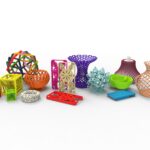I. What is Upcycled Art?
II. Benefits of Creating Upcycled Art
III. Popular Materials and Techniques for Upcycled Art
What is Upcycled Art?
Upcycled art is a fascinating blend of creativity and sustainability. At its core, it involves transforming discarded materials into beautiful, functional, or thought-provoking pieces of art. Imagine taking an old bicycle tire and turning it into a chic wall clock or using glass bottles to create stunning sculptures. Upcycled art breathes new life into items that might otherwise be tossed aside.
### The Philosophy Behind Upcycling
The concept of upcycling goes beyond mere recycling. While recycling typically involves breaking down materials to create new products, upcycling focuses on reimagining and repurposing materials in their existing forms. This artistic approach encourages innovators to think outside the box, taking what might seem like junk and elevating it to something extraordinary.
**Here’s why this matters**: In a world overflowing with waste, upcycled art serves as a reminder of the value in what we already have. It challenges the notion of disposable consumer culture and inspires a more mindful way of living and creating. Plus, it’s a fantastic way to reduce our ecological footprint while also sparking joy and creativity.
### The Creative Process
Creating upcycled art often involves a delightful mix of inspiration and resourcefulness. Artists may start with a vision or simply let the materials guide them. The process can be as simple as gathering items you would typically throw away—think of tin cans, old clothing, or broken furniture—and letting your imagination run wild.
You don’t need to be a seasoned artist to begin creating upcycled art. In fact, many individuals start as hobbyists, experimenting with different materials and techniques until they find their unique style. Whether you’re crafting a whimsical garden sculpture or a functional piece of furniture, the journey of exploration is what makes upcycled art so rewarding.
### Connecting with the Community
One of the wonderful aspects of upcycled art is its ability to foster community connections. Many artists share their work online, inspiring others to think creatively about waste. Upcycled art has gained traction in numerous communities, leading to workshops, exhibitions, and even art fairs dedicated to this eco-conscious movement.
If you’re interested in getting involved, consider joining a local upcycling group or attending workshops. These gatherings can be a great source of inspiration and an opportunity to meet like-minded individuals who share your passion for creativity and sustainability.
### The Joy of Discovery
As you embark on your upcycling journey, you may find joy in the unexpected. The beauty of upcycled art lies in its unpredictability; you never know what you might create! Each piece tells a story and carries with it a history—be it the old tennis racquet that became a unique picture frame or the vintage teacups turned into garden planters.
In conclusion, upcycled art is an engaging and fulfilling way to express your creativity while contributing to a more sustainable world. It invites you to see potential in the overlooked and encourages a playful, imaginative approach to crafting. So, gather those forgotten items around your home, unleash your creativity, and start your upcycling adventure today!
Benefits of Creating Upcycled Art
Creating upcycled art isn’t just about producing beautiful pieces; it offers a plethora of benefits that can enrich your life and the environment. Let’s dive into some of the most rewarding aspects of this creative endeavor!
1. Environmental Impact
One of the most significant advantages of upcycled art is its positive impact on the environment. By using materials that would otherwise end up in landfills, you’re:
- Reducing Waste: You’re giving new life to items like old bottles, scrap metal, and worn-out clothing.
- Conserving Resources: Using pre-loved materials means less demand for new resources, which helps reduce manufacturing waste.
- Promoting Sustainability: You’re actively participating in a movement that values sustainability and mindful consumption.
2. Cost-Effective Creativity
Upcycled art is incredibly budget-friendly! Instead of splurging on expensive materials, you can:
- Use What You Have: Look around your home! Old furniture, broken jewelry, and even packaging can be transformed into stunning artworks.
- Explore Thrift Stores: You can often find unique items at a fraction of the cost, opening up a treasure trove of possibilities for your next project.
This not only saves you money but also encourages you to think creatively about what you can repurpose!
3. Personal Expression
Creating upcycled art allows you to express your personality and share your story. Each piece you create can be:
- Unique: With upcycled materials, no two pieces will ever be the same, making your art a true reflection of your style.
- Thought-Provoking: Art made from discarded items can spark conversations about consumption, waste, and creativity.
- A Personal Journey: The process of creating can be therapeutic and a form of self-discovery, as you learn what resonates with you.
4. Community and Connection
Engaging in upcycled art can also foster a sense of community. Whether you’re participating in workshops or sharing your creations online, you can:
- Connect with Like-Minded Individuals: There’s a vibrant community of upcyclers who share tips, techniques, and encouragement.
- Inspire Others: Your work may motivate friends and family to think about sustainability and their consumption habits.
Art, in any form, creates connections, and upcycled art is no exception!
5. Skill Development
Upcycling art is a fantastic way to develop and hone various skills, including:
- Creative Problem Solving: You’ll learn to see potential in items that others might overlook.
- Craftsmanship: Whether you’re painting, sewing, or welding, you’ll improve your technical skills with each project.
- Innovation: Upcycling encourages innovative thinking as you figure out how to transform materials into something new.
So, why not give upcycled art a try? Not only will you enjoy the creative process, but you’ll also be contributing to a more sustainable planet. Dive in, explore, and let your imagination lead the way!
Popular Materials and Techniques for Upcycled Art
When it comes to upcycled art, the world is your oyster! You can transform just about anything that would usually end up in the landfill into a stunning piece of art. Let’s dive into some popular materials and techniques that can help spark your creativity.
Materials You Can Use
The beauty of upcycled art lies in its resourcefulness. Here are some common materials you might consider:
- Cardboard: Boxes from deliveries, old cereal boxes, and even toilet paper rolls can be cut, painted, and assembled into sculptures, wall art, or functional pieces like organizers.
- Glass: Wine bottles, jars, and old windows can be turned into lamps, vases, or decorative items. Just be careful with sharp edges!
- Textiles: Old clothes, linens, and fabric scraps can be sewn, tied, or glued together to create wall hangings, quilts, or even plush toys.
- Plastic: Milk jugs, bottle caps, and old utensils can become colorful sculptures or even functional garden art.
- Wood: Pallets, leftover lumber, and even driftwood can be transformed into furniture, signs, or garden features.
The key is to look at what you have around you and consider how it can be reimagined!
Techniques to Transform Your Materials
Now that you’ve gathered your materials, it’s time to roll up your sleeves and get creative! Here are some techniques that can breathe life into your upcycled treasures:
- Painting: A coat of paint can work wonders! Whether you’re sprucing up wood or glass, a splash of color can turn something dull into a statement piece. Consider using eco-friendly paints if you’re keen on sustainability.
- Collage: Combine different materials to create layered textures and visuals. This technique is perfect for cardboard and paper, allowing you to combine images, patterns, and textures from various sources.
- Assembly: Sometimes the best art comes from simply piecing together different objects. Use a hot glue gun or screws to attach various components into a cohesive piece. Think of it as a 3D puzzle!
- Embroidery or Sewing: If you’re working with textiles, sewing and embroidery can add unique details. You can stitch patches onto fabric, or even weave items together for a more intricate design.
- Decoupage: This technique involves gluing paper cutouts onto your base material and sealing them with a finish. It’s a fun way to incorporate images or text into your artwork, giving it a personal touch.
Getting Started
If you’re new to upcycled art, start small! Pick one or two materials and a technique you find intriguing. Remember, the process is just as important as the end result. Don’t be afraid to experiment and let your imagination run wild. The only rule is to have fun and let your creativity shine!
In conclusion, the world of upcycled art is vast and full of potential. By using everyday materials and different techniques, you not only reduce waste but also create something uniquely yours. So gather your supplies and start creating—who knows what masterpieces await you?





Comments